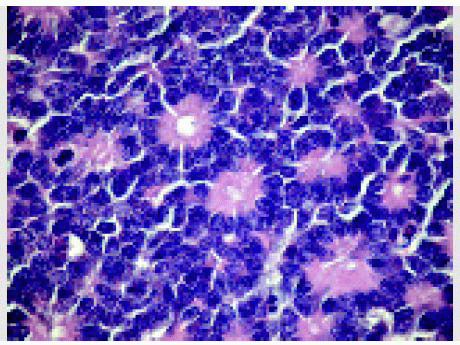 Retinoblastoma: Pathology
Retinoblastoma: PathologyRetinoblastoma: Pathology
Pathologically, retinoblastoma has characteristic gross and microscopic features (1,2). Grossly, it is a white tumor that arises from the sensory retina. The endophytic, exophytic, or diffuse growth pattern or combinations of them can usually be recognized easily on gross examination. The tumor often has chalky foci of calcification. Choroidal and optic nerve extension of the tumor can often be recognized on gross examination of the sectioned eye. Areas of tumor necrosis, hemorrhage, and choroidal and optic nerve extension can often be seen on gross examination.
Microscopically, retinoblastoma is a neuroblastic tumor with small, round cells. On low magnification, the tumor appears basophilic because of numerous closely arranged nuclei and scant cytoplasm. Areas of necrosis appear pink with scattered nuclei of tumor cells. Dystrophic calcification, seen in necrotic portions of the tumor, is basophilic and acellular.
The better-differentiated tumors contain Flexner-Winter-steiner rosettes and fleurettes. The more poorly differentiated tumors comprise mostly anaplastic cells without rosette or fleurette formation and have more nuclear pleomorphism and mitotic figures. Special stains and electron microscopy have confirmed that the rosettes represent an abortive attempt of the tumor cells to undergo photoreceptor differentiation (3). In some instances, the tumor cells are recognized in the anterior chamber, choroid, or optic nerve. The blood vessels in retinoblastoma are sometimes encircled by basophilic deposits. This is believed to represent deposited DNA liberated from necrotic tumor cells. Such deposition is sometimes seen in the iris and choroid where there is no direct tumor involvement.
Histopathologic studies can be helpful in prognosis for the patient with retinoblastoma. Risk factors for tumor recurrence of metastasis include the presence and degree of orbital extension, optic nerve extension, and choroidal extension (4,5). Cystlike cavities have been identified in some cases in retinoblastoma, and their presence is believed to be associated with better-differentiated tumors that would be more resistant to chemotherapy and radiotherapy (6).
Selected References
1. Eagle RC Jr. Retinoblastoma and other pediatric intraocular tumors. In: Eagle RC Jr, ed. Eye Pathology. Philadelphia: WB Saunders; 1999:199-217.
2. McLean IW. Retinoblastomas, retinocytomas, and pseudoretinoblastomas. In: Spencer WH, ed. Ophthalmic Pathology. An Atlas and Textbook, 4th ed. Philadelphia: WB Saunders; 1996:1340-1375.
3. Tso MOM, Zimmerman LE, Fine BS. The nature of retinoblastoma: photoreceptor differentiation: a clinical and histopathological study. Am J Ophthalmol 1970;69:3390-3399.
4. Shields CL, Shields JA, Baez K, et al. Choroidal invasion of retinoblastoma. Metastatic potential and clinical risk factors. Br J Ophthalmol 1993;77: 544-548.
Stay updated, free articles. Join our Telegram channel

Full access? Get Clinical Tree


